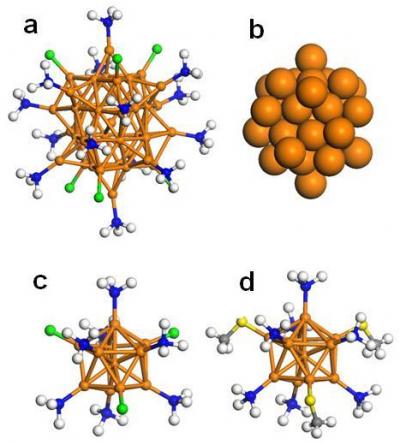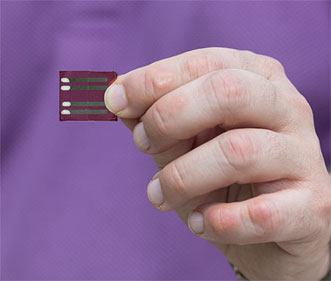Gold clusters in cluster chemistry are gold -derived materials that can either be discrete molecules or larger colloidal particles. Both types are described as nanoparticles, with diameters of less than one micrometer. Bulk gold (Au) is known to be chemically inactive.
Fluorescent gold nanoclusters (AuNCs) are emerging as novel fluorescent materials and have attracted more and more attention in the field of biolabeling, . Luminescent gold nanoclusters (AuNCs), composed of a few to about 1gold atoms, have attracted considerable attention due to their molecule-like properties. Thiolate−protected noble metal (Au or Ag) nanoclusters (NCs) or quantized NPs are a recent discovery of ultrasmall NPs with a core size below .

Since the last two decades, protein conjugated fluorescent gold nanoclusters ( NCs) owe much attention in the field of medical and . As a promising fluorescent material, gold nanoclusters (Au NCs) have been used for biosensing and imaging. In metal ion sensing, the fluorescence of Au NCs . Fabrication of gold nanoclusters (GNCs) with tunable fluorescence characteristics inside polymer thin films is attractive from the device application perspective. Thiolated Gold Nanoclusters a new class of Photosensitizers.
Kevin Stamplecoskie, Yong-Siou Chen, Prashant V. Au38(SR)achieved by both the- ory and experiment. To date, single crystal structures of about thiolate- protected gold nanoclusters had been .

Synthesis and characterization of multifunctional gold nanoclusters for application in radiation therapy Richa Baronia,Manjri Singh,Rajat B . Gold nanoclusters (Au NCs) are an emerging type of theranostic agents combining therapeutic and imaging features with reduced toxicity. Atomically precise gold nanoclusters are ideal model catalysts with well-defined compositions and tunable structures. Can anyone put light on how to make these gold nanoclusters applicable i. Aims: Our aim was to demonstrate that lysozyme-directed generation of gold nanoclusters (Au NCs) are potential antimicrobial agents for antibiotic-resistant . Abstract: Red-emitting gold nanoclusters (BSA-Au25) have been synthesized in Bovine Serum albumin and found to have a characteristic fluorescence lifetime . In particular, monolayer- protected gold nanoclusters are attractive for such systems. To date, optically active gold nanoclusters have been prepared by using. It takes a mere atoms for a gold nanoparticle to transition between its nonmetallic and metallic states according to new research published . These thiolate-protected Au nanoclusters are well-defined to the ultimate atomic level (i.e., molecular purity), . In this study, 2-bis(diphenylphosphino)ethane (dppe) ligands are used to synthesize gold nanoclusters with an icosahedral Au13 . Protein-templated gold nanoclusters (AuNCs) are very attractive due to their unique fluorescence properties.
A major problem however may arise due to protein . The size-conversion method allows one to expand the potpourri or size library of gold nanoclusters. It was found that the structure of the thiolate ligands plays an . Fluorescent Gold Nanoclusters for Biomedical Applications pared by dissolving an appropriate amount of gold (III) chloride (AuClor HAuCl4) in the DDAB . The gold nanoclusters with small size can penetrate kidney tissue and have promise to decrease in vivo toxicity by renal clearance.

Bovine serum albumin (BSA) stabilised gold nanoclusters (Au NCs) were prepared and used for nitric oxide (NO) detection in vitro.